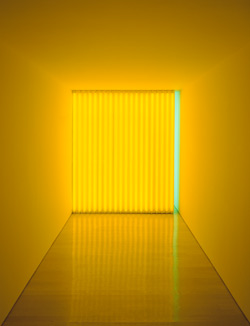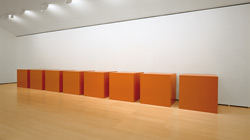Artist
Dan Flavin Untitled (to Jan and Ron Greenberg) 1972–73

Dan FLAVIN
American 1933–96
untitled (to Jan and Ron Greenberg) 1972–73
yellow and green fluorescent light, edition 1/3
246.4 x 213.4 x 25.4 cm
Solomon R. Guggenheim Museum, New York
Panza Collection
© Dan Flavin/ARS, New York. Licensed by VISCOPY, Australia
Photo by David Heald © Solomon R. Guggenheim Foundation, New York
91.3708
Dan Flavin creates sculptures using coloured fluorescent light tubes. His titles usually reflect dedications to people who influenced him. For Untitled (to Jan and Ron Greenberg), 1972-73, Flavin strips his sculptures down to the three elements of light, colour and space. It becomes a fusion of all these elements that the viewer must engage with to fully comprehend.
Untitled (to Jan and Ron Greenberg), 1972-73 is comprised of multiple yellow and green flourescent tubes set vertically in the centre of a corridor. Flavin has ingeniously left the width of one fluorescent tube open at one end, enabling light from the other side to be seen and the colours to fuse. This creates a narrow but intense contrast of light that pierces the corridor space. The wall of light becomes an architectural feature as well as the source of light. The light and colour bounces from the walls and ceiling enveloping the viewer and shadows play on each surface depending on the position of the viewer within the space.
Flavin has deconstructed his sculptural form to its essence – light and colour. The viewer must encounter the work from both sides to experience it as a whole. Flavin challenges the illusionary aspects of traditional use of light and colour in art. The form of his work circumvents the need for a frame or a pedestal.
Interpretation and Meaning
Some critics have interpreted Flavin’s sculptures as spiritual. Flavin spent a short time in the seminary as a young man, so many critics suggest that his light sculptures are like a literal interpretation of light as the symbol of enlightenment or God and an attempt to transcend time and space. It is not difficult to imagine such a response, because in effect you have to feel rather than see the sculpture.
Dan Flavin finds these very lofty interpretations too complicated. In response to this perspective, he has said:
It is what it is, and it ain’t nothin’ else...There is no overwhelming spirituality you are supposed to come
into contact with...It’s in a sense a “get-in-get-out” situation. And it is very easy to understand. One
might not think of light as a matter of fact, but I do. And it is, as I said, as plain and open and direct an
art as you will ever find.
Dan Flavin
Quoted in The Strange Case of the Fluorescent tube, by Michael Gibson, Art International 1 (Autumn
1987), p.105
Materials and Techniques
Flavin reassessed the types of materials that could be used for artwork. He did not want his fluorescent light tubes to be custom made. He was very determined that all the lights he used were standard commercially produced tubes that could be easily purchased in a hardware store. In doing so, Flavin took the common object out of its usual context to pioneer a challenging and new approach to sculpture. The simplicity of the singular light tube and the immediacy of the ambient light and colour are important features of his work. The uniformity and repetition of the materials is also significant for Flavin.
I am constantly for clarity and distinction...first in the pattern of the tubes and then with that of the
supporting pans. But with or without colour, I never neglect design.
Dan Flavin
Quoted in Dan Flavin, Proposals for the visible, by Beatrice von Bismarck, p.16
Some critics interpret this use of commercial materials as a ‘Neo-Duchampian readymade’. (See Art in America: in another light -– fluorescent light art, Dan Flavin, Dia Centre for the Arts, Guggenheim Museum, PaceWildenstein, New York, New York, by Richard Kalina, p. 1)
This refers to a controversial Dada artist named Marcel Duchamp. He placed ordinary objects in an art gallery and declared them to be art. An infamous example was when he signed a urinal "R.Mutt" and entited it Fountain 1917. Apart from shocking the public, he was primarily challenging the traditional idea of what art should be.
The Minimalists sought to remove emotion from their art work, quite opposite to the Abstract Expressionists who used gesture to convey an expressive personal response to their subject. Flavin's choice of commercially manufactured flourescent tubes contributes to creating that cool, clean, non-emotive aesthetic.
Robert Morris, a Minimalist artist, wrote:
The object has not become less important. It has merely become less self-important.
Robert Morris
Quoted in Dan Flavin, Proposals for the visible, by Beatrice von Bismarck, p.14
